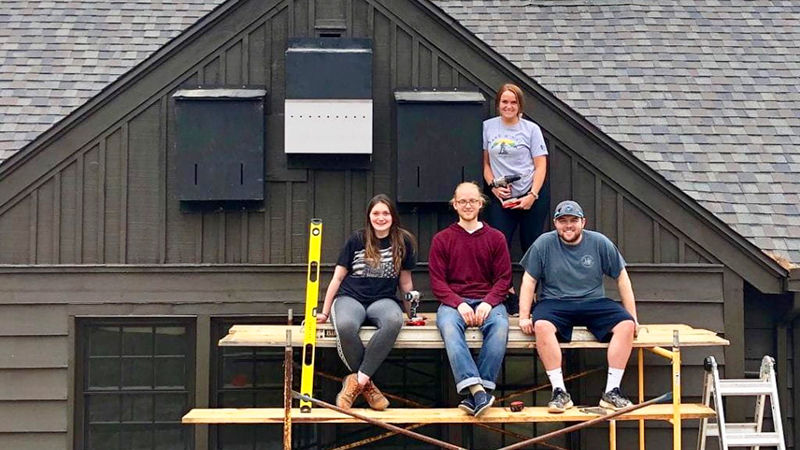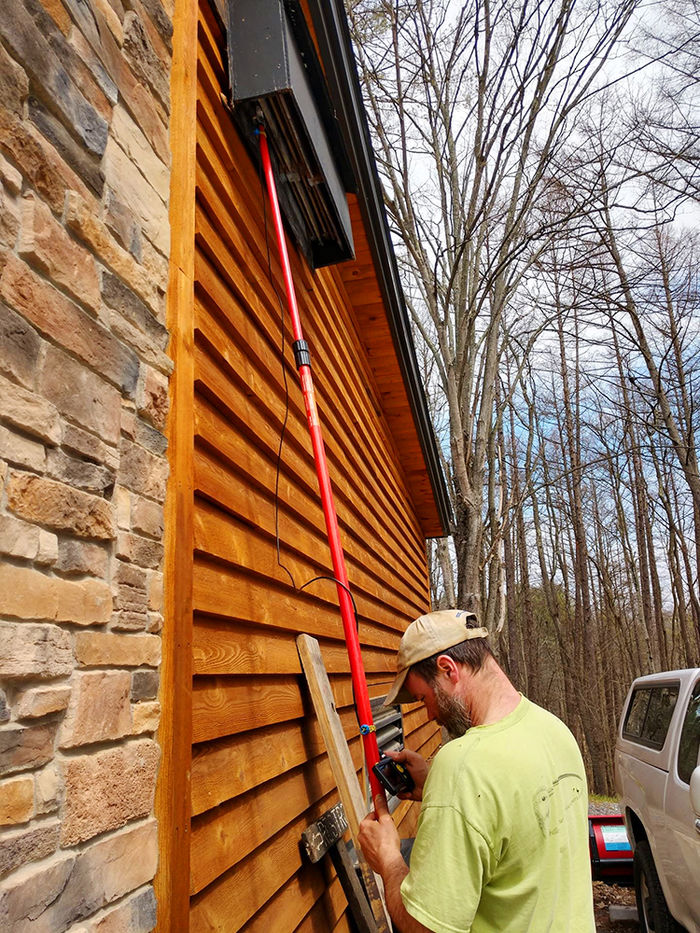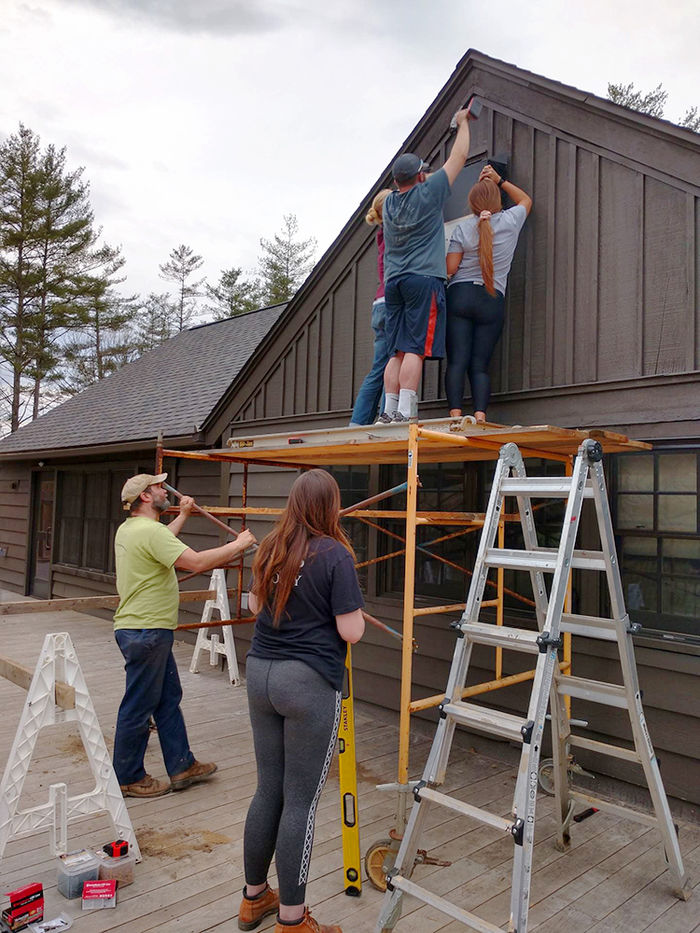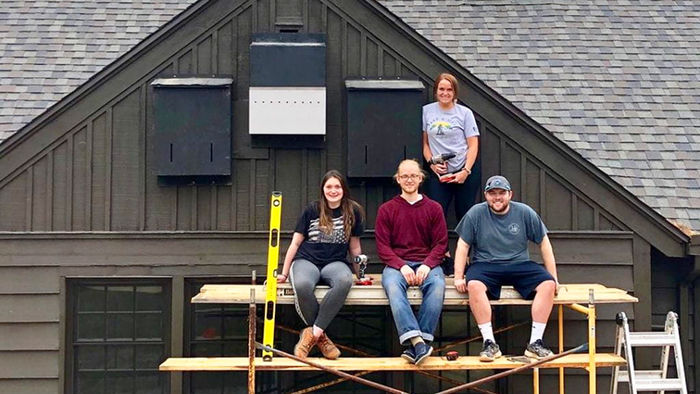

This dialog contains the full navigation menu for this site.


Jon Kauffman, assistant program director at Shaver’s Creek, uses a Borescope (attached to an old pruning saw) to check for bats in an existing box.
There are finally some small signs of hope for bats. Hit very hard by a fungal disease called “white-nose syndrome” over a decade ago, the bat population across the United States—including Pennsylvania’s little brown bats—has declined precipitously. Yet Michael Gannon, professor of biology at Penn State Altoona, who has been studying bats for decades, is optimistic. Numbers are rising slightly this year and “the hope is that we’re going to get some back.” To aid the bats, Gannon is working to “give them enough habitat, enough bat boxes, so that we have a chance of them coming back.”
For years, Shaver’s Creek Environmental Center, just outside State College, has welcomed bats. As a graduate student in the late 1980s and early 1990s, Lisa Williams studied bat boxes with the goal of building a better bat box. Doug Wentzel, who started at Shaver’s Creek as an intern in 1990 and is now a program director, says, “Shaver’s Creek was a hub for bat researchers because of Lisa’s work and the [existing] colony. She had a series of bat boxes up. She was measuring temperature and the best designs for bat boxes.”
Shaver’s Creek was also counting bats to keep track of the population. “The highest count was May 2007—1,434 little brown bats,” Wentzel says. He recalls years when “as part of the summer camp program we would watch the bats drop out of the boxes.” But then “white nose showed up in New York in 2007. No one really understood how quickly it spread. It was convenient that we had numbers when it came to Centre County. The first noticeable decline was 2010—that year we dropped below 1,000.” The next year numbers dropped significantly: “In 2011 the high count was 151 and in 2012 it was 69. In 2013 we went to a total of nine. In 2014 we had two.”

Bat boxes ready for installation.
White-nose syndrome disturbs a bat’s hibernation. Gannon explains: “It makes bats wake up in the winter.” At that time of year no food is available for them, “they can’t feed and end up dying.” It can be spread from bat to bat, but humans have a role in spreading it as well. “You walk through a cave, you disturb the hibernation. They use up their stores and die.” The best protection for the bats, as long as white-nose syndrome exists, is to “limit any activity, including bat counts,” during hibernation.
The good news is now that a few bats have returned to Shaver’s Creek, Gannon says, the goal is “to try to restore the bat population.” To do that, Shaver’s Creek staff asked Gannon and the Pennsylvania Game Commission to get involved. Gannon’s background in studying disturbances in bat populations makes him perfect for the project. “I did a lot of work in Puerto Rico and the Caribbean on the effect of hurricane disturbances on bats.” He also has worked closer to home, such as the Allegheny Forest when the Forest Service wanted to cut some trees.
Bats have a bad reputation in popular culture, but they don’t really want to fly in your hair. As the major predator of night-flying insects, many of which are agricultural pests, bats are a boon to insect control—a service they provide for free. Gannon points out that “the value of bats as agents of insect control (if humans had to do the job that bats do for free) is estimated at over $3 billion annually in Pennsylvania alone and in the trillions of dollars each year within the entire United States.”
But these pest patrollers need a place to live when they’re not out chasing insects. Bats spend the daylight hours roosted in dark places such as attics and caves. In the winter they hibernate. They like to stay in one area, so if boxes are available they will go back to the same boxes every year. That’s why it is important to provide them with habitat.

Positioning the box on the wall takes many hands.
One weekend this spring four Penn State Altoona students—Trey Koehle, Veronica Mysliwiec, Jordan Wolfkill, and Sage Heckendorn met Jon Kauffman, an assistant program director at Shaver’s Creek, at the visitors’ center to install three bat boxes. A sophomore environmental studies major, Koehle had originally approached Gannon about putting up a bat box on the Penn State Altoona campus. Gannon suggested instead that Koehle get involved in the bat-box installation at Shaver’s Creek.
Kauffman is very happy to see the bat boxes return. “I’ve always helped with the bat programs during our summer camp. I would have an interpretive hour with the public,” Kauffman says. “In recent years we have seen a few bats around—7 or 8. We want to encourage them to come back.” Shaver’s Creek has recently undergone major renovations, including new raptor enclosures. Once the decision was made to reinstall bat boxes, the Game Commission both donated seven boxes and came out to figure out the best location for them. The first three were placed on the back of the visitors’ center building.
So there is reason for optimism. As the population grows, Gannon and the staff at Shaver’s Creek have plans to “put up a permanent exhibit about bats,” Gannon says. There may even be new features: “Once we have bats coming, we might be able to install a webcam in the box.” If that happens, viewers from all over the world will be able to see the bats at Shaver’s Creek. And visitors will once again be able to watch at sunset as bats leave their boxes to hunt for insects.

Kauffman explains the installation plan to the students.

The students and Kauffman assemble the scaffolding.

Installation of the first three boxes is complete. (L-R) Veronica Mysliwiec, Trey Koehle, Sage Heckendorn, and Jordan Wolfkill


